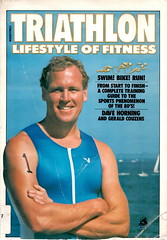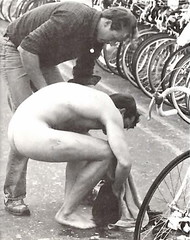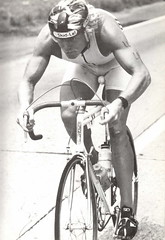So I’m on call all this weekend for work, which means basically that I can’t leave the house for three days (long NYE weekend) because I have to be within 15 minutes of my computer should anything decide to go splat over the holiday. That being the case, I stopped by to vist my friends at the awesome Chicago Public Library — it rules having the main branch of the public library of one of the nation’s largest cities within half a mile of your house, y’all — and perused their sports books to stock up on reading materials for my hibernation.
First, I picked up Swim, Bike, Run, Laugh!: A Lighthearted Look at the Serious Sport of Triathlon and the Ironman Experience, by Dan Madson. This is a short one, and it only took me maybe an hour to read. It’s not the sort of laugh-out-loud comedy of something like Trizophrenia: Inside the Minds of a Triathlete (which I highly recommend, and quote the line about five-to-ten minute socks from regularly), but it’s more along the lines of a gently humorous memoir. So, from the title, the “lighthearted” bit is more correct than the “laugh” bit — it had a few laugh out loud moments, but mostly it was the sort of smile-to-yourself kind. It was a slightly less manic volume of the “humorous Ironman experience” than How Triathlon Ruined My Life. Not bad, but I wouldn’t go out of my way to read it.
 The second read of the night was a 1985 book called Triathlon, Lifestyle of Fitness: Swim! Bike! Run! and billing itself as “A Complete Training Guide to the Sports Phenomenon of the 80s!” So obviously it’s 25 years out of date, but I was curious to see how things had changed — what sort of anecdotes about the sport there’d be, or how training advice would have changed, over that time and especially after the popularization of the sport.
The second read of the night was a 1985 book called Triathlon, Lifestyle of Fitness: Swim! Bike! Run! and billing itself as “A Complete Training Guide to the Sports Phenomenon of the 80s!” So obviously it’s 25 years out of date, but I was curious to see how things had changed — what sort of anecdotes about the sport there’d be, or how training advice would have changed, over that time and especially after the popularization of the sport.
It’s actually not all that bad, as it turns out, in terms of training advice — with at least one major exception — and it’s kind of fun to read the anecdotes and especially the section about bikes — probably the only book I’ve read that talks about sew-up tires at all, and definitely the only one to baffle me by talking about clincher tires as “wired on” (I kept picturing wire wrapped around the tire holding it to the wheel).
 Some of the photos are really great. From the photos you’d think that, in the 80s, all races were sponsored by either Crystal Light or Bud Light (wonder if they still handed out cola at the aid stations?). The author talks about having a special, custom one-piece suit made because he had a theory that having a single outfit to wear and not having to take “pit time” to change from a swimming outfit to a biking one could make the difference between winning or not — and mentions that the other athletes treated that idea with skepticism. So that’s kind of an interesting throwback if you’ve only ever competed in recent tris: imagine people actually wholesale changing clothes in transition! That no-nudity rule becomes even funnier.
Some of the photos are really great. From the photos you’d think that, in the 80s, all races were sponsored by either Crystal Light or Bud Light (wonder if they still handed out cola at the aid stations?). The author talks about having a special, custom one-piece suit made because he had a theory that having a single outfit to wear and not having to take “pit time” to change from a swimming outfit to a biking one could make the difference between winning or not — and mentions that the other athletes treated that idea with skepticism. So that’s kind of an interesting throwback if you’ve only ever competed in recent tris: imagine people actually wholesale changing clothes in transition! That no-nudity rule becomes even funnier.
 Most of the training advice seems usable, actually, which surprised me. (I guess that’s the problem with making assumptions about old books.) There was some flat-out bad advice about hydration — “Water: You Can Never Get Enough,” discouraging athletes from drinking sports drinks because he says it’s impossible to sweat out the micronutrients that they claim to replace, and pooh-poohing salt tablets as unnecessary. Maybe hyponatremia hadn’t been discovered to be a real problem in endurance athletics then, because it was still an emerging and relatively unpopular sport? — and the food stuff was out-of-date with regard to modern endurance nutrition products (though it’s understandable why he’d advise you to keep bananas and other actual food handy, since there was no gel and he wasn’t drinking Gatorade).
Most of the training advice seems usable, actually, which surprised me. (I guess that’s the problem with making assumptions about old books.) There was some flat-out bad advice about hydration — “Water: You Can Never Get Enough,” discouraging athletes from drinking sports drinks because he says it’s impossible to sweat out the micronutrients that they claim to replace, and pooh-poohing salt tablets as unnecessary. Maybe hyponatremia hadn’t been discovered to be a real problem in endurance athletics then, because it was still an emerging and relatively unpopular sport? — and the food stuff was out-of-date with regard to modern endurance nutrition products (though it’s understandable why he’d advise you to keep bananas and other actual food handy, since there was no gel and he wasn’t drinking Gatorade).
 But apart from that, there is a lot of decent stuff. He talks about the importance of cadence on the bike, especially spinning at high RPMs even though it feels weird (and the importance of not mashing because of the ineffectiveness and potential for injury), and how to use the entire pedal stroke to generate power (using clips rather than clipless pedals, of course, but the principle still applies). Some of the swim stroke advice is outdated (e.g., the S-shaped stroke is out of vogue these days, though I personally am still trying to break the 20-year habit), but who learns to swim from a book anyways? And he does advise people to find a coach or join a masters team to get real guidance. The running section explicitly advises a midfoot or heel strike, so at least that’s half correct by modern (fore- or midfoot strike) standards, and for whatever it’s worth, the reasons he advises against a forefoot strike are the same injury factors (Achilles, calves) that people caution you about when you start out a barefoot/natural/good form running program. And quite a bit of the advice is word-for-word still applicable, especially the parts about having all your stuff organized for transition so you don’t forget your shoes and have to run barefoot (oops), and not overtraining to burnout. Plus, the author talks about washing out of multiple Ironman races, so that goes a ways toward humanizing him and not making you think you’re reading something For The Serious Athlete Only™.
But apart from that, there is a lot of decent stuff. He talks about the importance of cadence on the bike, especially spinning at high RPMs even though it feels weird (and the importance of not mashing because of the ineffectiveness and potential for injury), and how to use the entire pedal stroke to generate power (using clips rather than clipless pedals, of course, but the principle still applies). Some of the swim stroke advice is outdated (e.g., the S-shaped stroke is out of vogue these days, though I personally am still trying to break the 20-year habit), but who learns to swim from a book anyways? And he does advise people to find a coach or join a masters team to get real guidance. The running section explicitly advises a midfoot or heel strike, so at least that’s half correct by modern (fore- or midfoot strike) standards, and for whatever it’s worth, the reasons he advises against a forefoot strike are the same injury factors (Achilles, calves) that people caution you about when you start out a barefoot/natural/good form running program. And quite a bit of the advice is word-for-word still applicable, especially the parts about having all your stuff organized for transition so you don’t forget your shoes and have to run barefoot (oops), and not overtraining to burnout. Plus, the author talks about washing out of multiple Ironman races, so that goes a ways toward humanizing him and not making you think you’re reading something For The Serious Athlete Only™.
So, my honest assessment of this out of print, out of date training book? You could do worse. Seriously, if you’re a new triathlete on a budget, for about two bucks for a used copy, this isn’t a bad book (if you ignore the part about drinking endless gallons of plain water and never taking in any electrolytes). And the pictures are pretty good too.